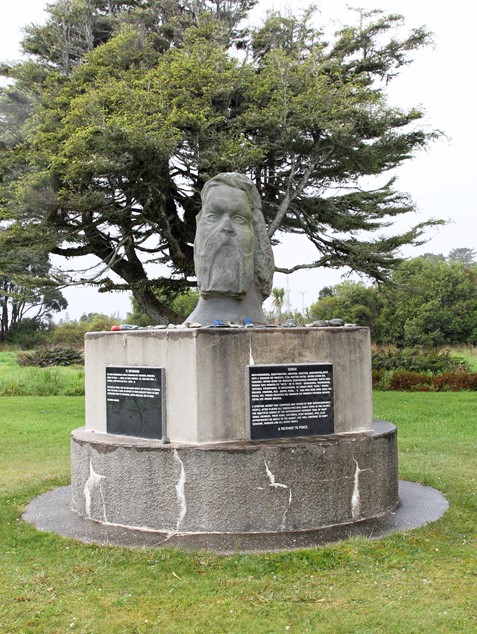The trials of Hokitika
Ngā Tāne o Parihaka
This is a story of the Parihaka men who were illegally arrested and transported from Taranaki to Hokitika in 1880 without trial. During their time here, they worked on developing local roads, Cass Square and the Seaview Terrace before their return in 1881.

Image supplied by Sue Asplin
The Parihaka settlement near the base of Taranaki Mounga was the first place in Aotearoa where peaceful resistance was used to stop land confiscations by Pākēhā settlers. This movement was inspiration to other peaceful resistance movements and activists around the world, including Mahatma Gandhi.
The movement, led by Te Whiti-o-Rongomai (Te Āti awa) and Tohu Kākahi ( Te Āti Awa, Taranaki), established Parihaka at Pungarehu. This location was picked because Te Āti Awa had significant plots of land forcibly stolen from them, namely Puke Ariki pā. The blocks of land at Pungarehu were owned by each of Te Whiti and Tohu’s wives, who were both of Taranaki Iwi and Ngā Ruahine.
Te Whiti and Tohu encouraged their followers to ‘pick up the plough - not the rifle’. They were regarded as a well organised, and peaceful community consisting of Māori from numerous iwi (tribes) and used the Raukura (three white albatross feathers) as a symbol of ‘faith, hope and compassion’. These messages were circulated and expanded on by Kapa Poi (poi practitioner groups).
The Taranaki conflict began in 1860 when the Government forcibly surveyed Māori land that was not for sale. Over the next 30 years, over 1.2 million acres of Taranaki land was subsequently confiscated. Te Whiti and Tohu preached peaceful resistance strategies to their followers in response to these confiscations, and to assert their ownership they removed survey pegs, built fences, and ploughed the land.
The New Zealand Government had invaded Parihaka and arrested almost 200 Māori men. These Parihaka Men were bought before the magistrate’s court for ‘malicious injury to property’ but they never faced trial. The Government, wishing to avoid an overblown trial for such petty offences, instead moved the Parihaka Men to gaols in Lyttleton, Dunedin and Hokitika.
The West Coast Times noted that ‘It would be gratifying to the feelings of the Pakeha here, to see 30 or 40 of Te Whiti’s deluded followers gradually coming to their senses while levelling Cass Square’. Thirty nine prisoners were reported to have arrived in Hokitika on 10 January 1880 on the Stella with 20 guards.
A special Māori day-room was constructed at the gaol to make the task of guarding the Parihaka men simpler; as they couldn’t be housed within the general goal population or be forced to work since they had not been convicted of any offense. The Parihaka Men quickly became dissatisfied with their ‘life of idleness’ and asked the Head Goaler, Mr Cleary for permission to work. Once granted, they set about clearing three acres of heavy bush on the Seaview Terrace, widened the road up to the Terrace, and leveled Cass Square.
It is also believed they worked on improving the Hau Hau Road. They were described by the West Coast Times as ‘very quiet and peaceable and established themselves as warm favorites’. Sadly, one of the men became ill and died in gaol, and two other men were released on 29 March due to health issues.
The Parihaka Men were never put on trial, and before long, changing public sentiment and protest resulted in their eventual release. On the 2 June 1881, the Government decided to release all the illegally imprisoned Parihaka Men. The Hokitika contingent left on the Stella on 13 June and were transported to Pātea.
The New Zealand Times reported that the Parihaka Men ‘appear stout and hearty’. The Parihaka Men spoke about their severe punishments ‘for trifles’ and the severe hard labour demanded of them.
Their troubles weren’t over; three months later the Parihaka settlement was again raided by the New Zealand Armed Constabulary. Approximately 2000 people sat quietly on the marae and children’s singing greeted the army. Te Whiti and Tohu were arrested, Parihaka was looted from, destroyed, livestock killed and any food sources were confiscated. The Parihaka Men were illegally imprisoned again and many were sent back to the South Island.
Back at Parihaka, the New Zealand Armed Constabulary continued to occupy Parihaka for 5 years where they evicted large groups of Māori families. In addition food and resources were prevented from being taken in to the township for much of the occupation. Throughout the constabulary’s occupation, remaining residents were forced to endure abuse on a daily basis from the occupying government officers.
It was not until 1883 that Te Whiti and Tohu were released and the village slowly rebuilt. Ploughing campaigns − and arrests without trial of protestors − continued into the 1890s.
In March 2000, a monument commemorating the Parihaka Men, who were illegally imprisoned, was unveiled in Hokitika by Taranaki Iwi at the sight of the old goal at Seaview. The unveiling was attended by a hikoi of about 300 Taranaki descendants of the Parihaka movement. The monument has a double-sided head representing the faces of Te Whiti and Tohu. Before leaving Hokitika, the Taranaki Hikoi were presented with a pounamu taonga by Ngāti Waewae representatives.
A reconciliation ceremony was held at Parihaka in June 2017 where the New Zealand Government made a formal apology for their actions against Parihaka Papakāinga.

